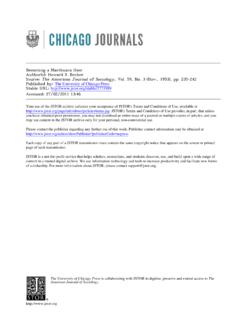Transcription of Psychological Safety and Learning Behavior in Work Teams
1 Psychological Safety and Learning Behavior in Work Teams Author(s): Amy Edmondson Source: Administrative Science Quarterly, Vol. 44, No. 2 (Jun., 1999), pp. 350-383. Published by: Johnson Graduate School of Management, Cornell University Stable URL: Accessed: 01/04/2009 23:19. Your use of the JSTOR archive indicates your acceptance of JSTOR's Terms and Conditions of Use, available at JSTOR's Terms and Conditions of Use provides, in part, that unless you have obtained prior permission, you may not download an entire issue of a journal or multiple copies of articles, and you may use content in the JSTOR archive only for your personal, non-commercial use. Please contact the publisher regarding any further use of this work.
2 Publisher contact information may be obtained at Each copy of any part of a JSTOR transmission must contain the same copyright notice that appears on the screen or printed page of such transmission. JSTOR is a not-for-profit organization founded in 1995 to build trusted digital archives for scholarship. We work with the scholarly community to preserve their work and the materials they rely upon, and to build a common research platform that promotes the discovery and use of these resources. For more information about JSTOR, please contact Johnson Graduate School of Management, Cornell University is collaborating with JSTOR to digitize, preserve and extend access to Administrative Science Quarterly. PsychologicalSafety This paper presents a model of team Learning and tests it and LearningBehavior in a multimethod field study.
3 It introduces the construct in WorkTeams of team Psychological Safety -a shared belief held by members of a team that the team is safe for interper- sonal risk taking-and models the effects of team psy- Amy Edmondson chological Safety and team efficacy together on Learning Harvard University and performance in organizational work Teams . Results of a study of 51 work Teams in a manufacturing com- pany, measuring antecedent, process, and outcome vari- ables, show that team Psychological Safety is associated with Learning Behavior , but team efficacy is not, when controlling for team Psychological Safety . As predicted, Learning Behavior mediates between team Psychological Safety and team performance. The results support an in- tegrative perspective in which both team structures, such as context support and team leader coaching, and shared beliefs shape team outcomes.
4 '. A growing relianceon Teams in changing and uncertainorga- nizationalenvironmentscreates a managerialimperativeto understandthe factors that enable team much has been written about Teams and about learningin organizations,our understandingof learningin Teams re- mains review of the team effectiveness and orga- nizationallearningliteraturesreveals markedlydifferentap- proaches and a lack of cross-fertilizationbetween them. An emerging literatureon group Learning ,with theoreticalpapers on groups as information-processingsystems and a number of empiricalstudies examininginformationexchange in labo- ratorygroups, has not investigatedthe learningprocesses of real work Teams (cf. Argote, Gruenfeld,and Naquin,1999).
5 Althoughmost studies of organizationallearninghave been field-based, empiricalresearch on group learninghas primar- ily taken place in the laboratory,and little research has been done to understandthe factors that influence learningbehav- ior in ongoing Teams in real organizations. Studies of work Teams in a varietyof organizationalsettings have shown that team effectiveness is enabled by structural features such as a well-designed team task, appropriate team composition, and a context that ensures the availability of information,resources, and rewards (Hackman,1987). Many researchers have concluded that structureand design, includingequipment, materials,physicalenvironment,and pay systems, are the most importantvariablesfor improving work-teamperformance(Goodman,Devadas, and Hughson, 1988; Campion,Medsker, and Higgs, 1993; Cohen and Led- ford, 1994) and have argued against focusing on interper- ?
6 1999 by Cornell University. sonal factors ( , Goodman, RavIin,and Schminke, 1987). 0001 -8392/99/4402-0350/$1 .00. Accordingto this research, organizationand team structures explain most of the variancein team effectiveness. I thank Richard Hackman for extensive advice and feedback on the design of this In contrast, organizationallearningresearch has emphasized study and on several versions of this pa- cognitive and interpersonalfactors to explaineffectiveness, per. Keith Murnighan, Rod Kramer, Mark Cannon, and three anonymous reviewers showing, for example, that individuals'tacit beliefs about in- provided feedback that greatly benefited terpersonalinteractioninhibitlearningbeh aviorand give rise the final version of the paper.
7 I gratefully to ineffectiveness in organizations( , Argyris,1993). This acknowledge the Division of Research at the Harvard Business School for provid- cognitive emphasis takes differentforms. Organizational ing financial support for this research. learningtheorists have offered both descriptivetheory ex- 350/AdministrativeScience Quarterly,44 (1999): 350-383. Psychological Safety plainingthe failureof organizationsto adapt rationallydue to cognitive biases that favor existing routines over alternatives ( , Levittand March,1988) and prescriptivetheory propos- ing interventionsthat alter individuals'"theories-in-use"to improveorganizationeffectiveness ( , Argyrisand Schdn, 1978). The formertheorists suggest that adaptive learningin social systems is fundamentallyproblematicand rare,and the latter,only slightlymore sanguine, propose that expert interventionis necessary to bringit about (cf.)
8 Edmondson and Moingeon, 1998). This paper takes a differentapproach to understandinglearningin organizationsby examiningto what extent and underwhat conditions learningoccurs natu- rallyin organizationalwork groups. Much organizationallearningresearch has reliedon qualita- tive studies that providerichdetail about cognitive and inter- personal processes but do not allow explicit hypothesis test- ing ( , Senge, 1990; Argyris,1993; Watkinsand Marsick, 1993). Manyteam studies, in contrast, have used large samples and quantitativedata but have not examined ante- cedents and consequences of learningbehavior( , Good- man, Devadas, and Hughson, 1988; Hackman,1990; Cohen and Ledford,1994). I propose that to understandlearning behaviorin Teams , team structuresand shared beliefs must be investigatedjointly,using both quantitativeand qualitative methods.
9 This paper presents a model of team learningand tests it in a multimethodfield study. The results support an integrative perspective in which both team structures, such as context supportand team leader coaching, and shared beliefs shape team outcomes. Organizationalwork Teams are groups that exist within the context of a largerorganization,have clearly defined membership,and share responsibilityfor a team productor service (Hackman,1987; Alderfer,1987). Their learningbehaviorconsists of activities carriedout by team members throughwhich a team obtains and processes data that allow it to adapt and improve. Examplesof learningbe- haviorinclude seeking feedback, sharinginformation,asking for help, talkingabout errors,and is throughthese activities that Teams can detect changes in the environment,learnabout customers' requirements,im- prove members' collective understandingof a situation,or discover unexpected consequences of their previousactions.
10 These useful outcomes often go unrealizedin organizations. Members of groups tend not to share the unique knowledge they hold, such that group discussions consist primarilyof jointlyheld information(Stasser and Titus, 1987), posing a dilemma for learningin groups. More centrally,those in a position to initiatelearningbehaviormay believe they are placingthemselves at risk;for example, by admittingan er- roror asking for help, an individualmay appear incompetent and thus suffer a blow to his or her image. In addition,such individualsmay incurmore tangible costs if their actions cre- ate unfavorableimpressions on people who influence deci- sions about promotions,raises, or projectassignments. Im- age costs have been explored in research on face saving, which has established that people value image and tacitly abide by social expectations to save their own and others'.













